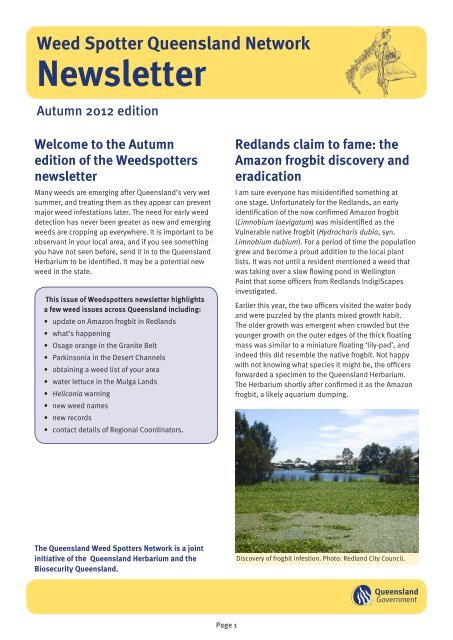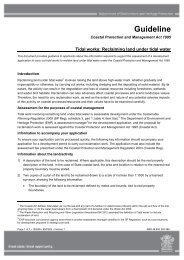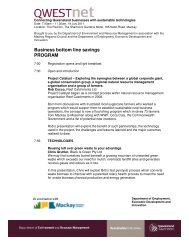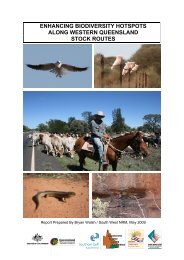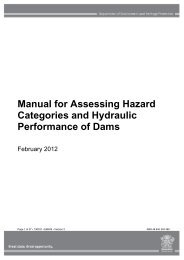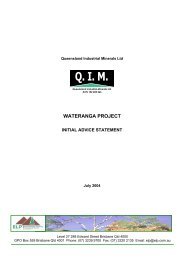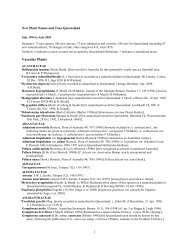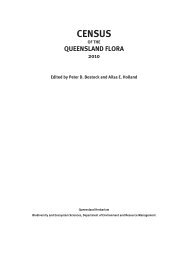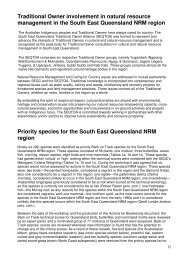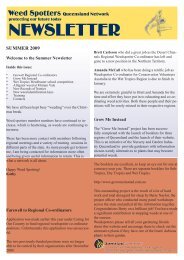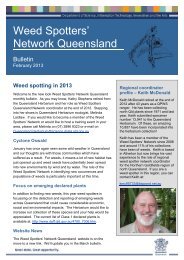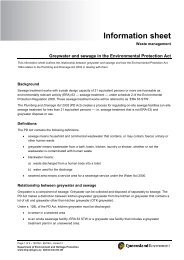Weed Spotter Queensland Network Newsletter Autumn 2012 edition
Weed Spotter Queensland Network Newsletter Autumn 2012 edition
Weed Spotter Queensland Network Newsletter Autumn 2012 edition
Create successful ePaper yourself
Turn your PDF publications into a flip-book with our unique Google optimized e-Paper software.
<strong>Weed</strong> <strong>Spotter</strong> <strong>Queensland</strong> <strong>Network</strong><br />
<strong>Newsletter</strong><br />
<strong>Autumn</strong> <strong>2012</strong> <strong>edition</strong><br />
Welcome to the <strong>Autumn</strong><br />
<strong>edition</strong> of the <strong>Weed</strong>spotters<br />
newsletter<br />
Many weeds are emerging after <strong>Queensland</strong>’s very wet<br />
summer, and treating them as they appear can prevent<br />
major weed infestations later. The need for early weed<br />
detection has never been greater as new and emerging<br />
weeds are cropping up everywhere. It is important to be<br />
observant in your local area, and if you see something<br />
you have not seen before, send it in to the <strong>Queensland</strong><br />
Herbarium to be identified. It may be a potential new<br />
weed in the state.<br />
This issue of <strong>Weed</strong>spotters newsletter highlights<br />
a few weed issues across <strong>Queensland</strong> including:<br />
• update on Amazon frogbit in Redlands<br />
• what’s happening<br />
• Osage orange in the Granite Belt<br />
• Parkinsonia in the Desert Channels<br />
• obtaining a weed list of your area<br />
• water lettuce in the Mulga Lands<br />
• Heliconia warning<br />
• new weed names<br />
• new records<br />
• contact details of Regional Coordinators.<br />
The <strong>Queensland</strong> <strong>Weed</strong> <strong>Spotter</strong>s <strong>Network</strong> is a joint<br />
initiative of the <strong>Queensland</strong> Herbarium and the<br />
Biosecurity <strong>Queensland</strong>.<br />
Page 1<br />
Redlands claim to fame: the<br />
Amazon frogbit discovery and<br />
eradication<br />
I am sure everyone has misidentified something at<br />
one stage. Unfortunately for the Redlands, an early<br />
identification of the now confirmed Amazon frogbit<br />
(Limnobium laevigatum) was misidentified as the<br />
Vulnerable native frogbit (Hydrocharis dubia, syn.<br />
Limnobium dubium). For a period of time the population<br />
grew and become a proud addition to the local plant<br />
lists. It was not until a resident mentioned a weed that<br />
was taking over a slow flowing pond in Wellington<br />
Point that some officers from Redlands IndigiScapes<br />
investigated.<br />
Earlier this year, the two officers visited the water body<br />
and were puzzled by the plants mixed growth habit.<br />
The older growth was emergent when crowded but the<br />
younger growth on the outer edges of the thick floating<br />
mass was similar to a miniature floating ‘lily-pad’, and<br />
indeed this did resemble the native frogbit. Not happy<br />
with not knowing what species it might be, the officers<br />
forwarded a specimen to the <strong>Queensland</strong> Herbarium.<br />
The Herbarium shortly after confirmed it as the Amazon<br />
frogbit, a likely aquarium dumping.<br />
Discovery of frogbit infestion. Photo: Redland City Council.
When the BioSecurity <strong>Queensland</strong> risk assessment of<br />
the Amazon frogbit came back as ‘high’ and it was the<br />
first naturalised record in <strong>Queensland</strong>, the Redland City<br />
Council promptly mapped its distribution and discovered<br />
it in an adjoining water body. Within a week, in May<br />
2011, the first treatment was undertaken. Follow-up<br />
treatments continued every two weeks for two months,<br />
then monthly. Monitoring was carried out at the same<br />
time.<br />
There has been no evidence of the Amazon frogbit<br />
for some months now and it is hoped that due to a<br />
confirmed identification and quick response it has<br />
been eradicated from the Redlands area. This situation<br />
Initial treatment of frogbit. Photo: Redland City Council.<br />
Eradication of frogbit achieved. Photo: Redland City Council.<br />
What’s happening?<br />
<strong>Weed</strong>s of Northern Australia: A Field Guide by Nicholas<br />
Smith is now available. Further information on costs and<br />
postage is available by contacting .<br />
The Australasian <strong>Weed</strong>s Conference is to be held in<br />
Melbourne, 8–11 October <strong>2012</strong>.<br />
The next <strong>Queensland</strong> <strong>Weed</strong>s Symposium will be held in<br />
South East <strong>Queensland</strong> in July 2013.<br />
Page 2<br />
shows the importance of early detection and how each<br />
weedspotter can contribute to preventing the spread of<br />
new and emerging weeds.<br />
In an unusual twist, the native frogbit (Hydrocharis<br />
dubium syn. Limnobium dubium) is now thought to be<br />
non-native (Bean 2011).<br />
References<br />
Bean, A.R. (2011). Hydrocharis dubia (Blume) Backer<br />
(Hydrocharitaceae) is an alien species in Australia.<br />
Austrobaileya 8(3): 225–440.<br />
Boyd Essex, Redland City Council.<br />
Midway in treatment of frogbit. Photo: Redland City Council.<br />
Emergent habit of frogbit when crowded. Photo: Redland City<br />
Council.<br />
<strong>Weed</strong>s of the Mackay District publication is presently in<br />
production.<br />
The first weeds phone app for <strong>Queensland</strong> is now a<br />
reality. <strong>Weed</strong>s: the ute guide is now available for iphone.<br />
It covers western weeds of grain crops, refer to<br />
.<br />
There is an online interactive lucid key to Australian<br />
weeds now available from .
Osage orange (Maclura pomifera) in the Granite Belt<br />
Osage orange is native to Texas/Arkansas areas of North<br />
America. This deciduous tree has escaped from garden<br />
plantings in the Granite Belt area of <strong>Queensland</strong> near<br />
Stanthorpe and near Armidale in New South Wales. It<br />
has formed thorny thickets principally in riparian areas,<br />
where its seeds continue to spread by water. It generally<br />
only attains a height of about 10 metres (Armidale area)<br />
but specimens in <strong>Queensland</strong> have grown to 20 metres<br />
high in the Pikedale area.<br />
It is related to the mulberry tree (family Moraceae)<br />
and not a citrus as the name suggests, although the<br />
fruit does have a distinctive citrus smell. It is generally<br />
planted for its ornamental and timber value. The leaves<br />
and stems exude a milky sap when damaged that can<br />
be an irritation to skin and eyes. It has light green<br />
ovate leaves with an acuminate tip and possesses<br />
two-centimetre-long thorns at each leaf scar along the<br />
stems. The trees bear a round rough green fruit similar in<br />
size to an orange. Separate male and female plants are<br />
required for reproduction.<br />
Craig Hunter, Biosecurity <strong>Queensland</strong>.<br />
Osage orange infestion. Photo: Craig Hunter.<br />
Page 3<br />
Foliage and thorns of Osage orange. Photo: Craig Hunter.<br />
Fruit of Osage orange. Photo: Craig Hunter.
Parkinsonia Dieback Project<br />
in the Desert Channels<br />
Parkinsonia (Parkinsonia aculeata) is a highly invasive<br />
weed of national significance, which has massive<br />
potential to spread through inland waterways and<br />
rangelands.<br />
Thanks to the combination of sharp eyes of NT Barkly<br />
Landcare Officer, Colleen Westover, who noticed<br />
unexplained deaths of Parkinsonia in 2004, a threeyear<br />
PhD study at the University of <strong>Queensland</strong> (UQ)<br />
by Naomi Diplock and the persistence of Dr Vic Galea,<br />
Associate Professor in plant pathology at UQ, around<br />
200 local fungal cultures have been identified which can<br />
cause Parkinsonia dieback. This is a naturally occurring<br />
event which kills Parkinsonia.<br />
Over the past 18 months landholders in western<br />
<strong>Queensland</strong> have been participating in a trial funded by<br />
Meat and Livestock Australia to test the effectiveness<br />
of pathogens. Coordinated by UQ, in partnership with<br />
regional NRM groups, 14 field days have been held (eight<br />
in 2010, and six follow up in 2011), and 70 trial sites<br />
have been set up with individual landholders. Results<br />
are promising, with trial participants reporting a range of<br />
responses including death and sickness of Parkinsonia<br />
trees in a variety of land types. The project leader is<br />
Dr Vic Galea, UQ, and supporters are Desert Channels<br />
Group, Southern Gulf Catchments, South West NRM,<br />
National Prickle Bush Management Group, Capricorn<br />
Pest Management and Biodiversity <strong>Queensland</strong>.<br />
Sue Ackers, Desert Channels <strong>Queensland</strong> Inc.<br />
Dr Ken Goulter removing a sample from a healthy Parkinsonia<br />
tree for laboratory testing at Holmleigh field day.<br />
Photo: Sue Ackers.<br />
Page 4<br />
Obtaining a weed list of<br />
your area<br />
The WildNet application delivers wildlife information<br />
and incorporates <strong>Queensland</strong> Herbarium specimen<br />
data (HERBRECS). This application is available online<br />
from and can be used by weed<br />
spotters to access weed information (images and notes),<br />
weed lists for their area of interest, and to determine<br />
if specimens have been lodged with the <strong>Queensland</strong><br />
Herbarium.<br />
A summary of how to access weed information from the<br />
site is provided below.<br />
Wildlife Online can be used to access species lists<br />
for protected areas, forestry areas, local government<br />
areas and areas defined using coordinates (which can<br />
be accessed from websites such as Google Maps). To<br />
access weed lists, users should select the ‘introduced’<br />
and ‘plant’ options. The ‘specimen’ option should be<br />
used to determine the species that have a specimen<br />
lodged with the <strong>Queensland</strong> Herbarium database. The<br />
outputs, which are emailed to the requester, are PDF or<br />
text files and include the number of records and number<br />
of specimens recorded for the area.<br />
WetlandInfo’s Wetland Information Summary Search<br />
allows internet users to view a range of summarised<br />
environmental information including wildlife statistics<br />
for basins, natural resource management regions and<br />
local government areas. Specific wildlife lists such as<br />
‘Introduced Plants’ can be accessed from the wildlife<br />
statistics table to display a number of attributes<br />
including number of specimens, number of occurrences<br />
and date of last sighting. Some species on the lists have<br />
links to species notes, images and internet pages and<br />
the lists can be downloaded.<br />
WetlandMaps is an interactive map service that gives<br />
users access to wetland information via a web-based<br />
Geographic Information System (GIS). As well as<br />
delivering spatial data including wetland mapping,<br />
WetlandMaps has tools for accessing wildlife and survey<br />
data. Species records can be mapped and records and<br />
survey data can be viewed using the inventory tool.<br />
The report tool can be used to generate fauna or flora<br />
lists for a range of area types (current displayed extent,<br />
selected polygon(s), buffered polygon(s) and drawn<br />
areas). The species list outputs are PDF or text files and<br />
include the number of records, number of specimens<br />
recorded for the area and date last seen.<br />
Any errors found within the information generated from<br />
these sites should be reported to the WildNet Team at<br />
to rectify.<br />
Noleen Brown.
Water lettuce success in the Mulga Lands<br />
Water lettuce (Pistia stratiotes) on the Warrego River at<br />
Cunnamulla has been increasing for more than 10 years<br />
in spite of yearly spraying and many litres of chemical.<br />
Water lettuce seemed to be winning the battle.<br />
However a bug, sourced from Brisbane City Council<br />
Biocontrol unit has been successful in eating its way<br />
through the entire infestation. The water lettuce weevil<br />
was reintroduced in November 2010 and no spray has<br />
been used for over 12 months. Last year a dense mat<br />
covered over two kilometres of the main waterhole, and<br />
water lettuce could be found for another eight kilometres<br />
down stream to the Allan Tannock Weir.<br />
The Allan Tannock Weir Irrigators Group called a meeting<br />
and a Water Lettuce Action Group was formed including<br />
representatives from the Paroo Shire, landholders<br />
and the Biosecurity <strong>Queensland</strong>. The group drafted an<br />
action plan for the Paroo Shire and we hope to see water<br />
lettuce eradicated within 10 years. Weevils will be used<br />
in the main attack, and then follow-up winter spraying<br />
will be trialled.<br />
Water lettuce forming mats across the river (photo Nov 2010)<br />
Photo: Tobias Bickel.<br />
Water lettuce absence November 2011. Photo: Suzanne Nicholls.<br />
Page 5<br />
Biosecurity Officer Stephen Downey said the weevil was<br />
excellent at reducing the mass of lettuce that is very<br />
expensive to spray.<br />
“By waiting until winter, after the weevil has killed<br />
most plants, there will be fewer plants to spray, and<br />
control will be more effective. There will still be seed<br />
germinating for many years to come, but water lettuce<br />
weevil can be sourced from the Brisbane City Council at<br />
the start of each summer to reintroduce into the river,”<br />
he said.<br />
The Warrego River flows into New South Wales and the<br />
Darling River, so the results are promising for those<br />
south of Cunnamulla. While no plants have ever been<br />
found south of the Weir at Cunnamulla, tonnes of plant<br />
material go over the weir each summer in floods, and it<br />
is only a matter of time before it makes it to the<br />
Darling River.<br />
Suzanne Nicholls, Bulloo Shire Council.<br />
Water lettuce plant with weevil damage. There are multiple<br />
marks on the leaves, some of the emerging new leaves are<br />
crippled and the plant is partly submerged. Entire damaged<br />
leaves are breaking off as well. Photo: Stephen Downey.
Heliconia warning<br />
Fresh warnings have arisen about the potential spread<br />
of common introduced plants found in the tropics,<br />
Heliconia species. Several species are being grown in<br />
local gardens. Heliconias are closely related to bananas<br />
and originate from tropical, central and south America.<br />
A few years ago a television program did a show about<br />
Heliconias and a Heliconia farm in the Northern Territory.<br />
The program reported that Heliconias had no seeds and<br />
if you wanted to grow your own you had to buy plants.<br />
Also, that Australia did not have pollinating agents, so<br />
it was safe to grow Heliconias as they would not spread<br />
into the environment.<br />
Heliconia showing bright purple-blue fruit. Photo: S&A<br />
Pearson.<br />
New weed names<br />
New names for cat’s claw creeper and thorny Acacias:<br />
Page 6<br />
At the time we were seeing Sunbirds visiting our three<br />
different Heliconias species (H. collinsiana, H. humilis,<br />
H. psittacorum) and this was followed by fruiting of each<br />
species. Later, we saw Black Butcher Birds visiting the<br />
ripe fruit and eating them. Now we are finding small<br />
Heliconia plants coming up in the rainforest around<br />
our home. Residents of the north where Sunbirds and<br />
Black Butcher Birds are present should be vigilant for<br />
seedlings coming up in their area.<br />
Anyone who suspects the presence of an emerging<br />
Heliconia seedling problem should contact their local<br />
weeds officer for further information.<br />
Steve and Alison Pearson<br />
Sunbird on Heliconia flower. Photo: S&A Pearson.<br />
Cat’s claw creeper, Macfadyena unguis-cati has had a name change and is now called Dolichandra unguis-cati (L.)L.<br />
Lohmann.<br />
This is based on molecular data (see Lohmann (2006, 2009) American Journal of Botany). This name change has now<br />
been generally accepted by Australian and overseas herbaria (Gordon Guymer pers. comm.19-12-2011).<br />
Acacia name changes:<br />
Following the International Botanical Congress in 2011, it has now been agreed that the thorny Acacias belong to<br />
a separate genus Vachellia. The new names for the thorny acacias known to occur in <strong>Queensland</strong> are given below.<br />
Please be aware that there are also some native Vachellia species, so get a confirmed identification before controlling<br />
the introduced Vachellia species.<br />
Ailsa Holland, <strong>Queensland</strong> Herbarium.<br />
Old name New name Status<br />
Acacia bidwillii Vachellia bidwillii native<br />
Acacia clarksoniana Vachellia clarksoniana native<br />
Acacia ditricha Vachellia ditricha native<br />
*Acacia farnesiana *Vachellia farnesiana naturalised<br />
*Acacia karroo *Vachellia karroo doubtfully naturalised<br />
*Acacia nilotica *Vachellia nilotica naturalised<br />
Acacia sutherlandii Vachellia sutherlandii native<br />
*non-native
Some new weed records up to December 2011 Supplied by the <strong>Queensland</strong> Herbarium<br />
*Amaranthus dubius Mart. ex Thell.<br />
Status: doubtfully naturalised, second<br />
record, first in SEQ<br />
Collector: Trevor Armstrong<br />
Date: 17 June 2011<br />
Location: Rocklea<br />
Notes: Creekbank situation on alluvium<br />
*Andropogon gayanus Kunth<br />
Class 2 range extension<br />
Collector: Keith McDonald<br />
Date: July 2011<br />
Location: Millstream Falls NP<br />
*Asystasia gangetica subsp. micrantha<br />
(Nees) Ensermu<br />
Status: new naturalisation<br />
Collector: Tony Bean<br />
Date: April 2011<br />
Location: Shoal Water Bay Training Area<br />
*Brillantaisia lamium (Nees) Benth.<br />
Status: priority sleeper weed<br />
Collector: S.G. McKenna<br />
Date: 17 April 2011<br />
Location: S 17 50 28.3 E 145 59 30.5<br />
*Bryophyllum daigremontianum<br />
(Raym.-Hamet & H.Perrier) A.Berger<br />
Class 2 large extension of range<br />
Collector: Daniel McCudden, DEEDI<br />
Date: 13 July 11<br />
Location: Charleville<br />
*Cecropia Loefl. sp.<br />
Class 1<br />
Collector: Luke Pavich<br />
Date: July 2011<br />
Location: Clifton Beach (Cairns area)<br />
*Chromolaena odorata (L.) R.M.King &<br />
H.Rob.<br />
Class 1<br />
Collector: Stephen McKenna AQIS<br />
Date: 9 August 11<br />
Location: Cape York<br />
Notes: Single plant, removed after<br />
collection.<br />
*Cylindropuntia imbricata (Haw.)<br />
F.M.Knuth<br />
Class 2 range extension<br />
Collector: Susan Walters<br />
Date: 12 July 11<br />
Location: Springsure.<br />
*Cymbopogon nardus (L.) Rendle var.<br />
confertiflorus (Steud.) Stapf ex Bor<br />
Status: new naturalisation for<br />
<strong>Queensland</strong><br />
Collector: Sonia MacDonald<br />
Date: 15 September 11<br />
Location: SE of Noosaville<br />
*Dalbergia latifolia Roxb.<br />
Status: new naturalisation recognised<br />
Collector: I.G.Champion<br />
Date: May 2011<br />
Location: SW of Eton township<br />
*Evolvulus nummularius (L.)L.<br />
Status: potential new weed<br />
Collector: Keith McDonald<br />
Coll. date: 16 January 2008<br />
Location: Mt Surprise township<br />
*Hygrophila polysperma (Roxb.)<br />
T.Anderson<br />
Status: BQ special watch<br />
Collector: Matt Birch<br />
Date: 20 June 11<br />
Location: Babinda<br />
*Hymenachne amplexicaule (Rudge)<br />
Nees<br />
Class 2 plant; WONS<br />
Collector: Craig Magnussen<br />
Date: March 2011<br />
Location: Gayndah<br />
*Indigofera vohemarensis Baill.<br />
Status: new naturalisation, new for<br />
Australia<br />
Collector: Tony Bean<br />
Date: April 2011<br />
Location: Shoal Water Bay Training Area<br />
*Limnobium laevigatum ( Humb. &<br />
Bonpl. ex Willd. ) Heine<br />
Status: first record NQ , second record<br />
Qld (new naturalisation March 2011 in<br />
SEQ)<br />
Collector: J A Walker<br />
Date: 1 September 11<br />
Location: near Cairns<br />
Notes : Cultivated aquatic in freshwater<br />
pond.<br />
*Miscanthus sinensis Andersson<br />
Status: previously cultivated, potential<br />
new weed.<br />
Collector: G.Calvert<br />
Date: July 2011<br />
Location: Townsville, along beachfront<br />
Page 7<br />
*Nassella neesiana (Trin. & Rupr.)<br />
Barkworth<br />
Class 1<br />
Collector: Craig Hunter<br />
Date: 10 November 11<br />
Location: south of Pittsworth, Darling<br />
Downs<br />
*Parthenium hysterophorus L.<br />
Class 2<br />
Collector: Rose Moore<br />
Date: 14 April 2011<br />
Location: Porcupine Gorge NP, 60km N<br />
of Hughenden.<br />
Notes: known in the area, controlled in<br />
the park<br />
*Pereskia aculeata Mill.<br />
Status: NEAL<br />
Collector: D. Lloyd<br />
Date: 25 August 11<br />
Location: Cairns.<br />
*Schmidtia pappophorides Steud. ex<br />
J.A.Schmidt<br />
Status: possible new naturalisation,<br />
previously cultivated<br />
Collector: Peter Connelly<br />
Date: 29 April 2011<br />
Location: Charleville.<br />
Notes: Small area, currently under<br />
eradication.<br />
*Senecio madagascariensis Poir.<br />
Status: Significant range of extension<br />
Class 2<br />
Collector: Juliet Musgrave<br />
Date: 7 August 2011<br />
Location: Hervey Bay<br />
Notes: Plants removed as a precaution.<br />
*Sida ciliaris L.<br />
Status: new naturalisation, new for<br />
Australia<br />
Collector: David Halford<br />
Date: April 2011<br />
Location: Shoal Water Bay Training Area<br />
*Stevia ovata Willd.<br />
Status: Herbarium list new weed<br />
spreading<br />
Collector: S.G. McKenna<br />
Date: 17 April 2011<br />
Location: Tully Falls NP<br />
Collector: Brett Carlsson Biosecurity QLD<br />
Date: 1 June 11<br />
Location: Ravenshoe<br />
Notes: Up to 1-1.5m tall. Thousands of<br />
mature individuals & seedlings.
Regional coordinators – contact details<br />
If you think you have a new weed, contact your Regional<br />
Coordinator:<br />
Bribie Island<br />
John Talbot<br />
Mobile: 0438 580 036<br />
Email: tropicaljohn@hotmail.com<br />
Bundaberg<br />
Ian Read<br />
Phone: (07) 4159 9365<br />
Email: ian.read7@bigpond.com<br />
Cairns<br />
Stephen McKenna<br />
Australian Quarantine and Inspection Service (AQIS)<br />
Phone: (07) 4030 7800<br />
Email: Stephen.mckenna@daff.gov.au<br />
Cape York<br />
Gerry Turpin<br />
DERM James Cook University, Cairns<br />
Phone: (07) 4042 1809<br />
Email: gerry.turpin@qld.gov.au<br />
Cloncurry (and Mt Isa, Gulf catchments)<br />
Tiffany Daley<br />
Biosecurity <strong>Queensland</strong><br />
Mobile: 0488 423 539<br />
Email: Tiffany.daley@qld.gov.au<br />
Emerald (and Central Highlands)<br />
Megan Daniels<br />
Central Highlands Regional Resources Use<br />
Planning Co-operative<br />
Phone: (07) 4982 2996<br />
Mobile: 0427 729 085<br />
Email: megan@chrrup.org<br />
Gympie (and Sunshine Coast)<br />
Ernie Rider<br />
Gympie Landcare<br />
Email: theejs.rider@gmail.com<br />
Hervey Bay (and Fraser Coast)<br />
Juliet Musgrave<br />
Fraser Coast Regional Council<br />
Phone: (07) 4197 4470<br />
Mobile: 0409 891 072<br />
Email: Juliet.musgrave@frasercoast.qld.gov.au<br />
Longreach (and Desert Channels)<br />
Sue Ackers<br />
Desert Channels <strong>Queensland</strong> Inc.<br />
Phone: (07) 4652 7817<br />
Mobile: 0459 990 536<br />
Email: sue.ackers@dcq.org.au<br />
Page 8<br />
Mackay<br />
Peter Alden<br />
DEEDI<br />
Phone: (07) 4967 0602<br />
Mobile: 0407 120 104<br />
Email: peter.alden@qld.gov.au<br />
Roma<br />
Lavinnia Fiedler<br />
Phone: (07) 3170 6506<br />
Mobile: 0417 212 476<br />
Email: lavinnia.fiedler@fluor.com<br />
Dalby (and Darling Downs, Granite Belt)<br />
Craig Hunter<br />
DEEDI<br />
Phone: (07) 4669 0828<br />
Mobile: 0428 584 908<br />
Email: craig.hunter@qld.gov.au<br />
Thargomindah (and mulga lands)<br />
Suzanne Nicholls<br />
Bulloo Shire Council<br />
Phone: (07) 4621 8000<br />
Email: suzanneN@bulloo.qld.gov.au<br />
Toowoomba<br />
Sandy Robertson<br />
<strong>Queensland</strong> Murray-Darling Committee Inc.<br />
Phone: (07) 4637 6228<br />
Mobile: 0428 710 690<br />
Email: sandyr@qmdc.org.au<br />
Toowoomba<br />
Alexandra Kennedy<br />
Condamine Alliance<br />
Phone: (07) 4620 0119<br />
Mobile: 0439 673 083<br />
Email: alexandra.kennedy@condaminealliance.com.au<br />
Wondai<br />
Nora Brandli<br />
Burnett Mary Regional Group<br />
Phone: (07) 4169 0720<br />
Mobile: 0429 462 467<br />
Email: nora.brandli@bmrg.org.au<br />
Contact Kathy Stephens if you are interested in becoming a Regional Coordinator.<br />
<strong>Weed</strong> <strong>Spotter</strong>s <strong>Queensland</strong> <strong>Network</strong> coordinator<br />
Kathy Stephens<br />
<strong>Queensland</strong> Herbarium<br />
Phone: (07) 3896 9316<br />
Mobile: 0428 756 620<br />
Email: kathy.stephens@qld.gov.au<br />
#30076


